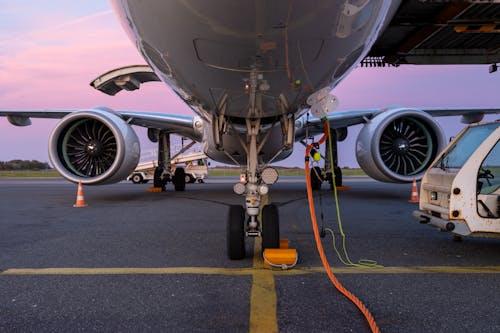The aviation industry has seen significant growth in recent years, with global air traffic volumes reaching new heights. This growth has paved the way for a surge in demand for airport stand equipment. Airport stand equipment, which includes ground support equipment (GSE) such as aircraft tugs, pushback tractors, passenger boarding bridges (PBBs), and de-icing systems, plays a crucial role in ensuring smooth and efficient airport operations. With the ongoing expansion of airports and the increasing focus on safety and efficiency, the airport stand equipment market holds significant potential for growth in the coming years.
Market Overview and Drivers
The global airport stand equipment market is driven by several factors, with the key one being the expansion of air travel. The International Air Transport Association (IATA) forecasts that global passenger traffic will double by 2037, reaching 8.2 billion passengers. This increase in passengers directly correlates with a rise in the demand for efficient airport operations, thereby driving the need for high-quality and advanced airport stand equipment.
Another major driver of the market is the ongoing expansion and modernization of airports worldwide. As airports upgrade their infrastructure to accommodate more passengers and larger aircraft, the need for advanced ground support equipment becomes critical. Additionally, the increasing focus on sustainability and environmental concerns has led to the development of more eco-friendly and energy-efficient airport stand equipment. These innovations are expected to play a pivotal role in shaping the market's growth trajectory.
Types of Airport Stand Equipment
-
Passenger Boarding Bridges (PBBs): PBBs are vital for ensuring a smooth transition between the terminal and the aircraft. As airports grow, so does the need for additional and more sophisticated PBBs. These bridges are increasingly being designed to handle larger aircraft and provide more seamless connections for passengers.
-
Aircraft Pushback Tractors and Tugs: Pushback tractors and tugs are essential for the safe and efficient movement of aircraft on the ground. These vehicles are used to push aircraft away from the gate and taxi to the runway. The increasing size and complexity of aircraft are driving demand for more powerful and specialized pushback tractors.
-
De-icing Equipment: De-icing is an essential part of airport operations, particularly in colder regions where snow and ice can impede aircraft movement. As climate conditions continue to vary, demand for de-icing equipment is expected to rise. Newer de-icing systems that are more environmentally friendly and efficient are being developed to meet this need.
-
Ground Power Units (GPUs): GPUs provide electrical power to aircraft while they are parked at the gate, ensuring that air conditioning, lighting, and other systems remain operational. With airports becoming more reliant on green energy solutions, there is a growing market for eco-friendly GPUs.
-
Baggage Handling Systems: Advanced baggage handling systems, which include automated sorting and tracking systems, are crucial for improving operational efficiency. These systems reduce manual handling, minimize errors, and help in managing high volumes of luggage, contributing to overall airport productivity.
Regional Market Insights
North America and Europe have historically been the largest markets for airport stand equipment, owing to the region's well-established and modernized airport infrastructure. However, the Asia-Pacific (APAC) region is expected to witness the highest growth in the coming years. With countries like China, India, and Japan ramping up investments in airport infrastructure to meet the growing demand for air travel, the APAC region offers vast opportunities for the airport stand equipment market.
In the Middle East, countries such as the United Arab Emirates and Qatar have been investing heavily in state-of-the-art airports to cater to international travelers, further boosting the demand for high-tech airport stand equipment. Likewise, Africa, although slower to develop, is gradually seeing investments in airport infrastructure, and this trend is expected to accelerate as economies grow.
Technological Advancements and Innovations
Technological innovations are playing a central role in transforming the airport stand equipment market. Automated and smart systems are becoming more prevalent, improving operational efficiency and safety. For instance, automated baggage handling systems and smart pushback tractors are reducing human error and improving the speed of operations. Additionally, the rise of electric-powered ground support equipment is helping airports meet their sustainability goals.
Furthermore, the integration of the Internet of Things (IoT) in airport stand equipment allows for real-time monitoring and data collection. This enables airport authorities to manage their equipment more effectively, predict maintenance needs, and optimize their operations. As airports continue to embrace digital transformation, such technologies are set to redefine the airport stand equipment market.
Challenges and Opportunities
Despite the promising growth potential, there are challenges that could hinder the growth of the airport stand equipment market. High capital investment for advanced systems and equipment, combined with the need for regular maintenance, can strain airport budgets, especially for smaller or regional airports. Additionally, there may be regulatory hurdles regarding safety standards and environmental compliance that could delay the adoption of new technologies.
However, these challenges also present opportunities for companies in the market to innovate and offer cost-effective solutions that cater to the needs of airports at various stages of development. Companies focusing on the development of sustainable and energy-efficient equipment, as well as automated and smart systems, are well-positioned to capitalize on the growing demand for modernized airport infrastructure.
Conclusion
The airport stand equipment market is poised for significant growth, driven by increasing passenger traffic, expanding airport infrastructure, and advancements in technology. As airports continue to modernize and adopt more sustainable practices, the demand for innovative and efficient ground support equipment will rise. This presents vast opportunities for stakeholders in the airport stand equipment industry, especially those focused on offering cutting-edge, eco-friendly, and automated solutions. The market’s potential is immense, and the next few years will likely see rapid growth in response to the evolving needs of the aviation industry.







